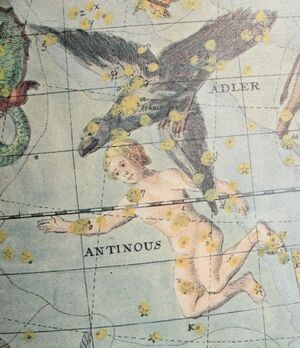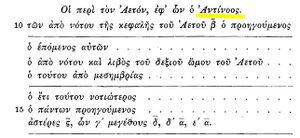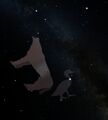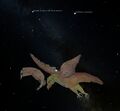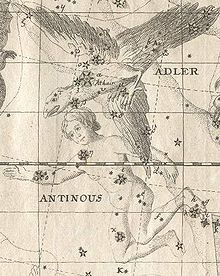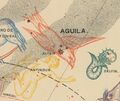Antinous: Difference between revisions
Ericmamajek (talk | contribs) (information on alternative names found in modern media for tet Aql) |
No edit summary |
||
| (48 intermediate revisions by 5 users not shown) | |||
| Line 1: | Line 1: | ||
[[File:Adlerantinous web-1-474x275.jpg|alt=Antinous (Bode1781)|thumb|Antinous in Bode (1781)]]A "sub"-constellation (or asterism) Antinous was created by Ptolemy of Alexandria and published in the Almagest star catalogue 137 CE. It is placed in the constellation of [[Aquila]], The Eagle. |
[[File:Adlerantinous web-1-474x275.jpg|alt=Antinous (Bode1781)|thumb|Antinous in Bode (1781)]]A "sub"-constellation (or asterism) Antinous was created by Ptolemy of Alexandria and published in the Almagest star catalogue 137 CE. It is placed in the constellation of [[Aquila]], The Eagle. |
||
=== Graeco-Babylonian Origin of the asterism name === |
|||
=== Name === |
|||
---- |
|||
==== Origin of the name/ story behind it ==== |
|||
[[wikipedia:Antinous|Antinous]] is the name of the boy lover of Emperor [[wikipedia:Hadrian|Hadrian of Rome]]. When Hadrian was in Egypt, Antinous drowned in the Nile. It was unclear from the outset whether this was an accident, suicide or murder. Of course, it can no longer be clarified today. The fact is that he fell into the water, could not swim and drowned. The grief-stricken emperor then declared a state of mourning in the Roman Empire and a cult of veneration began: Hadrian had a temple built for Antinous in the city of Rome, Antinous games were held in Athens and the astronomer Ptolemy of Alexandria placed the name of the deceased among the stars by inventing a new constellation. |
|||
=== The Roman (hi)story behind it === |
|||
In the sky, Antinous was now part of the constellation of the Eagle, and in the ''Almagest'' the stars are listed as a separate group in this constellation. |
|||
[[wikipedia:Antinous|Antinous]] is the name of one of the closest confidants of Emperor [[wikipedia:Hadrian|Hadrian of Rome]]. When Hadrian was in Egypt, Antinous drowned in the Nile. It was unclear from the outset whether this was an accident, suicide or murder. Of course, this can no longer be clarified today. The fact is that he fell into the water, could not swim and drowned. |
|||
Following the event and its mysterious reasons, several cults were created, in antiquity as well as early modern age. |
|||
Interestingly, the eagle is one of the "Greek" constellations that are taken directly from Babylonian uranography. The Babylonians also had a bird of prey, an eagle (or a vulture), in exactly the same place in the sky. Next to the Babylonian constellation Eagle is the Babylonian constellation The Corpse. Since the Almagest contains many Babylonian reminiscences (e.g. Babylonian eclipse observations are quoted), it could be that Ptolemy's new creation refers to the older Babylonian constellation and merely changes its name. |
|||
# '''Deification in Antiquity.''' The grief-stricken emperor then declared a state of mourning in the Roman Empire and a cult of veneration began: Hadrian had a temple built for Antinous in the city of Rome, Antinous games were held in Athens and the astronomer Ptolemy of Alexandria placed the name of the deceased among the stars by inventing a new constellation. |
|||
The '''Babylonian astronomical compendium MUL.APIN''' is of unknown date but certainly compiled before 1000 BCE. Definition in MUL.APIN list I.1 (line I ii 12): |
|||
# '''New Constellation in the ''Almagest?''''' The stars are listed as a separate group in the constellation of the Eagle which was taken over from ancient Babylon. As the Babylonian uranology has a constellation The Corpse in this area, it suggests that "Antinous" was just a new name for an old constellation. |
|||
# '''Revival in modern European history.''' The figure was drawn again in historical maps in early modern age, and it became an icon in Victorian England of the 19th century. |
|||
* ''original:'' DIŠ MUL <sup>d</sup>Za-ba<sub>4</sub>-ba<sub>4</sub> [[A2.mušen|<sup>mul</sup>Ti<sub>8</sub><sup>mušen</sup>]] u [[AD6|<sup>mul</sup>AD<sub>6</sub>]] |
|||
* ''Akkadian:'' Kakkab Zababa [[Eru|Erû]] u [[Pagru]] |
|||
* ''English:'' The asterism of God Zababa, the Eagle, and the Dead Man. |
|||
Obviously, the Babylonian Dead Man (or Corpse) forms part of a constellation together with the Eagle and with the god Zababa (a warlike god and city god of Kish, identified with the god of war Ninurta). |
|||
In the '''Hathor temple in Dendera (Egypt)''', there are two zodiakoi: a rectangular zodiac in the pronaos which is in drawn in the typical Egyptian style in an extraordinarily high ceiling, in two lanes across the whole depth of the room, and a small circular zodiac in the ceiling of the pronaos of a small Osiris chapel at the roof of the Hathor temple. This ceiling is low, touchable by human hands, as the whole room is hardly high enough for average people. Therefore, this star chart is not as divine as the one in the entrance hall of the temple. Hoffmann (2022) suggested that the whole map is a Babylonian star chart in Greco-Egyptian painting style. |
|||
* At the place of the Babylonian Eagle and the Corpse, there is a duck and an animal cadaver. |
|||
<gallery> |
|||
File:Aql Ptolbst.png|Aquila in the Almagest carrying a Corpse |
|||
File:Eagle+Corpse Dendera-zodiac2022.jpg|In the circular zodiac in Dendera (Roman time Egypt), at the place of the Ealge, a Duck is depicted. Next to it, we find the corpse of an animal. It may be placed on the stars of Delphinus or south of the duck but somewhere in this area. This is a visualiation produced for Stellarium (Hoffmann 2022). |
|||
File:Eagle+Corpse MULAPIN-jessica2022.jpg|Babylonian constellations The Eagle and The Corpse, drawn by Jessica Gullberg for the planetarium software Stellarium, cf. Gullberg, Hoffmann, Gullberg (2022) |
|||
File:Aqldel ptolbabtxt.png|possible Babylonian model of Eagle and Corpse next to the constellation of The Pig in IAU-Delphinus, suggested by S.M. Hoffmann (2018). The man and the bird are drawn as described in Ptolemy's Almagest. |
|||
</gallery> |
|||
==== Our modern dedication ==== |
|||
Ian Ridpath in his website ''Star Tales'' describes Hadrian as the first openly gay Roman Emperor, and Antinous as his boy lover. It may have been pederasty or a usual homosexual relation. Therefore, aiming at inclusion, astronomers of the 20th and 21st century prefer to use this asterism as a symbol of homosexuality in general (and not to link it with pederasty). |
|||
=== Reference(s) === |
|||
==== Historical source: Almagest (Toomer 1984) ==== |
==== Historical source: Almagest (Toomer 1984) ==== |
||
[[File:Eagle Almagest Antinous hi.JPG|alt=screenshot of page|thumb|Antinous in the original ancient Greek version of the Almagest (written by Ptolemy of Alexandria 137 CE, printed edition by Heiberg 1898).]] |
|||
[[File:Aql Ptolbst.png|thumb|Aquila with Antinous in Almagest (smh 2017)]] |
[[File:Aql Ptolbst.png|thumb|Aquila with Antinous in Almagest (smh 2017)]] |
||
Toomer's English translation of the Almagest (1984, page 357) gives for the constellation of Aquila: |
Toomer's English translation of the Almagest (1984, page 357) gives for the constellation of Aquila: |
||
| Line 40: | Line 22: | ||
# The one in advance of this, on the neck (ß Aql) |
# The one in advance of this, on the neck (ß Aql) |
||
# The bright star on the place between the shoulders, called μετάφρενον (Aquila) (α Aql)) |
# The bright star on the place between the shoulders, called μετάφρενον (Aquila) (α Aql)) |
||
# The one close to this towards the north (o Aql) |
# The one close to this towards the north (o Aql) |
||
# The more advanced of the 2 in the left shoulder (γ Aql) |
# The more advanced of the 2 in the left shoulder (γ Aql) |
||
# The rearmost of them (φ Aql)) |
# The rearmost of them (φ Aql)) |
||
| Line 54: | Line 36: | ||
# The star most in advance of all (λ Aql) |
# The star most in advance of all (λ Aql) |
||
==== |
==== Babylonian root ==== |
||
Interestingly, the eagle is one of the "Greek" constellations that are taken directly from Babylonian uranography. The Babylonians also had a bird of prey, an eagle (or a vulture), in exactly the same place in the sky. Next to the Babylonian constellation Eagle is the Babylonian constellation The Corpse. Since the Almagest contains many Babylonian reminiscences (e.g. Babylonian eclipse observations are quoted), it could be that Ptolemy's new creation refers to the older Babylonian constellation and merely changes its name. |
|||
The '''Babylonian astronomical compendium MUL.APIN''' is of unknown date but certainly compiled before 1000 BCE. Definition in MUL.APIN list I.1 (line I ii 12): |
|||
* ''original:'' DIŠ MUL <sup>d</sup>Za-ba<sub>4</sub>-ba<sub>4</sub> [[A2.mušen|<sup>mul</sup>Ti<sub>8</sub><sup>mušen</sup>]] u [[AD6|<sup>mul</sup>AD<sub>6</sub>]] |
|||
* ''Akkadian:'' Kakkab Zababa [[Eru_(Eagle)|Erû]] u [[Pagru]] |
|||
* ''English:'' The asterism of God Zababa, the Eagle, and the Dead Man. |
|||
Obviously, the Babylonian Dead Man (or Corpse) forms part of a constellation together with the Eagle and with the god Zababa (a warlike god and city god of Kish, identified with the god of war Ninurta). |
|||
==== Further ancient mentionings ==== |
|||
In the '''Hathor temple in Dendera (Egypt)''', there are two zodiakoi: a rectangular zodiac in the pronaos which is in drawn in the typical Egyptian style in an extraordinarily high ceiling, in two lanes across the whole depth of the room, and a small circular zodiac in the ceiling of the pronaos of a small Osiris chapel at the roof of the Hathor temple. This ceiling is low, touchable by human hands, as the whole room is hardly high enough for average people. Therefore, this star chart is not as divine as the one in the entrance hall of the temple. Hoffmann (2022) suggested that the whole map is a Babylonian star chart in Greco-Egyptian painting style. |
|||
* At the place of the Babylonian Eagle and the Corpse, there is a duck and an animal cadaver. |
|||
<gallery> |
|||
File:Aql Ptolbst.png|Aquila in the Almagest carrying a Corpse |
|||
File:Eagle+Corpse Dendera-zodiac2022.jpg|In the circular zodiac in Dendera (Roman time Egypt), at the place of the Ealge, a Duck is depicted. Next to it, we find the corpse of an animal. It may be placed on the stars of Delphinus or south of the duck but somewhere in this area. This is a visualiation produced for Stellarium (Hoffmann 2022). |
|||
File:Eagle+Corpse MULAPIN-jessica2022.jpg|Babylonian constellations The Eagle and The Corpse, drawn by Jessica Gullberg for the planetarium software Stellarium, cf. Gullberg, Hoffmann, Gullberg (2022) |
|||
File:Aqldel ptolbabtxt.png|possible Babylonian model of Eagle and Corpse next to the constellation of The Pig in IAU-Delphinus, suggested by S.M. Hoffmann (2018). The man and the bird are drawn as described in Ptolemy's Almagest. |
|||
</gallery> |
|||
== Ancient, Medieval and Early Modern sources and reception == |
|||
[[File:Antinous mentioned in text.png|alt=screenshot of Latin text|thumb|????]] |
|||
==== Cassius Dio (165 - 235 CE) ==== |
|||
The Greek-speaking Roman historian [[wikipedia:Cassius_Dio|Cassius Dio]] writes in his Roman History (quoted here is the Epitome of Book LXIX, 11 in the Loeb Classical Library edition):<blockquote>"In Egypt also he [=Hadrian] rebuilt the city named henceforth for Antinoos. Antinoos was from Bithynium, a city of Bithynia, which we also call Claudiopolis; he had been a favourite of the emperor and had died in Egypt, either by falling into the Nile, as Hadrian writes, or, as the truth is, by being offered in sacrifice. For Hadrian, as I have stated, was always very curious and employed divinations and incantations of all kinds. Accordingly, he honoured Antinoos, either because of his love for him or because the youth had voluntarily undertaken to die (it being necessary that a life should be surrendered freely for the accomplishment of the ends Hadrian had in view), by building a city on the spot where he had suffered this fate and naming it after him; and he also set up statues, or rather sacred images of him, practically all over the world. Finally, he declared that he had seen a star which he took to be that of Antinoos, and gladly lent an ear to the fictitious tales woven by his associates to the effect that the star had really come into being from the spirit of Antinoos and had then appeared for the first time. On this account, then, he became the object of some ridicule, and also because at the death of his sister Paulina he had not immediately paid her any honour..."</blockquote> |
|||
==== Historia Augusta (time span 117 to 284/5 CE, from Late Antiquity) ==== |
|||
The [[wikipedia:Historia_Augusta|Historia Augusta]] (SHA, Hadrian, 14,5f.) also covers the death of Antinoos:<blockquote>"5 During a journey on the Nile he lost Antinous, his favourite, and for this youth he wept like a woman. 6 Concerning this incident there are varying rumours; for some claim that he had devoted himself to death for Hadrian, and others — what both his beauty and Hadrian's sensuality suggest. 7 But however this may be, the Greeks deified him at Hadrian's request, and declared that oracles were given through his agency, but these, it is commonly asserted, were composed by Hadrian himself."</blockquote> |
|||
==== Medieval Sources ==== |
|||
{| class="wikitable" |
|||
|+ |
|||
!Author |
|||
!Commentary |
|||
|- |
|||
|Leiden Aratea (around 840) |
|||
|without Antinous |
|||
|- |
|||
|Gerard of Cremona (c. 1114-1187) |
|||
|Translation of Ptolemy's ''Almagest'' from the Arabic - without Antinous |
|||
|- |
|||
|Michael Scotus (c. 1180 - c. 1235) |
|||
|without Antinous |
|||
|- |
|||
|Georg Trazepunt (1396 - 1484) |
|||
|Translation of Ptolemy's ''Almagest'' from the Greek - with Antinous |
|||
|} |
|||
==== Early Modern Sources ==== |
|||
{| class="wikitable" |
|||
|+ |
|||
!Author |
|||
! |
|||
|- |
|||
|Reintroduction by Caspar Vopel |
|||
|Antinous appears as a name underneath the head of the Eagle on Vopel's [https://www.kulturelles-erbe-koeln.de/documents/obj/05741337/rba_d022262_09 1532 manuscript globe]. Vopel also added a figure of Antinous on his 1536 printed globe and depicts him before the act of sacrifice. |
|||
|- |
|||
|Tycho Brahe - ''Progymnasmata'' (1602) |
|||
|Johannes Kepler edited Tycho Brahe's star catalogue and published it as part of the ''[https://www.digitale-sammlungen.de/de/view/bsb10861238?page=322,323 Astronomiae Instauratae Progymnasmata]'' in 1602. Antinous (p. 268) follows the constellation Vultur (p. 267), which is Aquila. |
|||
|- |
|||
|Bayer's ''Uranographia'' (1603) |
|||
|Johann Bayer adds "''Ganymedis raptrix''" and "''Servans Antinoum''" as variants in the introductory text to plate 16, covering the constellation Aquila. In the star list for Aquila, he names the figure hanging from the eagle as Ganymede. |
|||
|- |
|||
|Jacob Bartsch, ''Usus astronomicus planisphaerii stellati'' (1623) |
|||
|Bartsch adds Antinous to his list of constellations (in the chapter ''De fixis seu asterismis'') and writes (Bartsch (1623), Usus astronomicus, p. 56):<blockquote>"XX. ANTINOVS puer Aquilae subiicitur, cuius stellae olim informes ad Aquilam numeratae a Ptolemaeus post iussu Adriani imperatoris formatae, cuius is fuit amasius. Aliis Ganymedes dicitur, de unguibus aquilae suspensus, quem Iupiter in coelum rapuit."</blockquote><blockquote>"20. ANTINOUS, the boy who was placed underneath the Eagle, whose unformed stars once were numbered to Aquila by Ptolemy, after an order of Emperor Hadrian, of whom he was a lover. By others he is called Ganymede, suspended from the claws of the eagle, which Jupiter stole away into the sky."</blockquote> |
|||
|} |
|||
== Depictions == |
|||
[[File:Bode1801 Aql.jpg|alt=map with drawn Antinous|thumb|Aquila with Antinous, Bode (1782) uncoloured]] |
|||
==== Early Modern Depiction(s) ==== |
|||
* [https://www.e-rara.ch/zut/content/zoom/77472?query=uranometria Bayer ''Uranometria'' (1603)] |
* [https://www.e-rara.ch/zut/content/zoom/77472?query=uranometria Bayer ''Uranometria'' (1603)] |
||
*[https://repository.ou.edu/uuid/bf60154b-6c8f-51a3-bfd0-f8835ad931e9 Flamsteed's ''Atlas Coelestis'' (1729)] did not show Antinous |
*[https://repository.ou.edu/uuid/bf60154b-6c8f-51a3-bfd0-f8835ad931e9 Flamsteed's ''Atlas Coelestis'' (1729)] did not show Antinous |
||
| Line 60: | Line 113: | ||
*[https://www.digitale-sammlungen.de/de/view/bsb10806460?page=29 Bode ''Vorstellung der Gestirne'' (1782, 1805)] |
*[https://www.digitale-sammlungen.de/de/view/bsb10806460?page=29 Bode ''Vorstellung der Gestirne'' (1782, 1805)] |
||
* [https://www.e-rara.ch/zut/content/zoom/3341773 Bode ''Uranographia'' (1801)] |
* [https://www.e-rara.ch/zut/content/zoom/3341773 Bode ''Uranographia'' (1801)] |
||
<gallery> |
|||
===Weblinks=== |
|||
File:Aratea 54v and 55r.jpg|Aquila with Sagitta, Leiden Aratea, Fol. 54v and 55r, between circa 830 and circa 840 |
|||
File:Aquila Uranometria.jpg|Aquila et Antinous (Bayer 1603) |
|||
File:Johannes Hevelius - Prodromus Astronomia - Volume III "Firmamentum Sobiescianum, sive uranographia" - Tavola R - Aquila et Antinous.jpg|''Aquila et Antinous'' in Hevelius (1690) in ''Firmamentum Sobiescianum, sive uranographia'' in volume ''Prodromus Astronomia'' |
|||
File:Sidney Hall - Urania's Mirror - Delphinus, Sagitta, Aquila, and Antinous.jpg|"Delphinus, Sagitta, Aquila, and Antinous", plate 13 in ''Urania's Mirror'', a set of celestial cards accompanied by ''A Familiar Treatise on Astronomy ...'' by Jehoshaphat Aspin (1825). London. Astronomical chart, print on layered paper board : etching, hand-colored. |
|||
File:1776 - John Flamsteed - L'Aigle, Antinous, La Fleche, Le Renard, Le Dauphin (Aquila, Sagitta, Vulpecula & Anser Delphinus).jpg|Aquila et Antinous, 1776 - Jean Fortin/ John Flamsteed - L'Aigle, Antinous, La Fleche, Le Renard, Le Dauphin (Aquila, Sagitta, Vulpecula & Anser Delphinus, [https://www.raremaps.com/gallery/detail/66194/laigle-antinous-la-fleche-le-renard-le-dauphin-aquila-flamsteed-fortin source]) |
|||
File:Aql bode.jpg|The constellation of Aquila (Eagle) and the constellation of Antinous, portrayed as Zeus and Ganymede, from the ''Uranographia'', by Johann Elert Bode (1782). |
|||
File:Simon Antinous spanish1894.jpg|Aquila et Antinous at ''Planisferio celeste'' (Carlos Simón 1894) |
|||
</gallery> |
|||
== Suggested for IAU-CSN == |
|||
*https://scilogs.spektrum.de/uhura-uraniae/sternbilder-der-adler-und-der-junge/ |
|||
The name "Antinous" has been proposed for Theta Aquilae (head of Ptolemy's figure). |
|||
==== Modern dedication (symbol for or against homosexuality) ==== |
|||
====References==== |
|||
Ian Ridpath in his website ''Star Tales'' describes Hadrian as the first openly gay Roman Emperor, and Antinous as his boy lover. This statement continues the view of Antinous ''as a symbol'' of male homosexuality in the contemporary Western culture, a view created by the literature by Oscar Wilde (1854-1900), Fernando Pessoa (1888-1935) and Marguerite Yourcenar (1903-1987). Occasionally, the symbol figure of Antinous is used by the LGPTQ community as one of their icons. Therefore, aiming at inclusion, astronomers of the 20th and 21st century occasionally use this asterism as a symbol of homosexuality in general. |
|||
However, it must also be pointed out that Antinous who died before his 20th birthday was a teenager while the emperor Hadrian was in his 40s. Thus, their relationship - if it was not only Platonic - may have been pederasty which is today considered as a form of child abuse and therefore condemned in modern society (astronomers, planetarians, and everybody else who uses the term "Antinous"). |
|||
* Allen (1899) on "Antinoüs" [https://penelope.uchicago.edu/Thayer/E/Gazetteer/Topics/astronomy/_Texts/secondary/ALLSTA/Antinous*.html weblink] |
|||
* Gullberg, Jessica, Susanne M Hoffmann, Steven R. Gullberg (2022). Painting Babylonian, in: Hoffmann and Wolfschmidt (eds.): Astronomy in Culture – Cultures of Astronomy. Proceedings of the Splinter Meeting in the Annual Meeting of the German Astronomical Society, Sept. 14-16, 2021., Reihe: Nuncius Hamburgensis 57, tredition, Hamburg & OpenScienceTechnology Berlin (cBook), pp. 171-191 |
|||
* Hoffmann, S.M. (2022). Preliminary Observations on the Dendera Zodiac (Egypt). in: Hoffmann and Wolfschmidt (eds.): Astronomy in Culture – Cultures of Astronomy. Proceedings of the Splinter Meeting in the Annual Meeting of the German Astronomical Society, Sept. 14-16, 2021., Reihe: Nuncius Hamburgensis 57, tredition, Hamburg & OpenScienceTechnology Berlin (cBook), pp. 524-541 |
|||
* Hoffmann, Susanne M : Als der Löwe an den Himmel kam, Franckh-Kosmos-Verlag Stuttgart 2021, p. 86-88 |
|||
* Ian Ridpath: [http://www.ianridpath.com/startales/antinous.html Star Tales – Antinous] |
|||
==== Cultural Astronomy Concerns ==== |
|||
===Suggested for IAU-CSN by=== |
|||
For [[wikipedia:Theta_Aquilae|Theta Aquilae (tet Aql) the wikipedia]] mentions some alternatives, e.g. the Chinese constellation [[Tianfu]] that consists of four stars (cf. also Allen 1899 spelling it Tseen Foo, The Heavenly Raft with a wrong number of stars). After double checking this name and its history, the Chinese WGSN-members prefer to use "Tianfu" for Tau Aql and neither for Eta nor Theta. The Rhoads (1971) NASA catalog of star names has "Almizan III" but a) WGSN tries to avoid Roman numerals in names, b) there is a triplet called "Almizan" and we can use one of the other stars to adopt this names. |
|||
The name "Antinous" has been proposed to be used for theta Aquilae (head of Ptolemy's figure). |
|||
Hence there is no conflict with Antinous. |
|||
==== Decision ==== |
|||
The name Antinous is applied to Theta Aquilae. |
|||
== References == |
|||
===Weblinks=== |
|||
* Ian Ridpath: [http://www.ianridpath.com/startales/antinous.html Star Tales – Antinous] |
|||
* Ian Ridpath: [http://www.ianridpath.com/startales/aquila.html#antinous Star Tales – Aquila: An obsolete subdivision] |
|||
* https://scilogs.spektrum.de/uhura-uraniae/sternbilder-der-adler-und-der-junge/ |
|||
=== Literature === |
|||
For [[wikipedia:Theta_Aquilae|theta Aqliae (tet Aql) the wikipedia]] mentions some alternatives, e.g. the Chinese constellation [[Tianfu]] that consists of four stars (cf. also Allen 1899 spelling it Tseen Foo, The Heavenly Raft with a wrong number of stars). After double checking this name and its history, the Chinese WGSN-members prefer to use "Tianfu" for tau Aql and neither for eta nor theta. The Rhoads (1971) NASA catalog of star names has "Almizan III" but a) WGSN tries to avoid Roman numerals in names, b) there is a triplet called "Almizan" and we can use one of the other stars to adopt this names. Hence there is no conflict with Antinous. |
|||
* Allen, Richard Hinckley, ''Star-Names and their Meanings'' (New York/London: G.E. Stechert, 1899), pp. 40-41 [[https://archive.org/details/star-names-and-their-meanings/page/40/mode/1up?view=theater Internet Archive link] / [https://penelope.uchicago.edu/Thayer/E/Gazetteer/Topics/astronomy/_Texts/secondary/ALLSTA/Antinous*.html Caelum Antiquum link]]. |
|||
* Dekker, Elly, "Caspar Vopel's Ventures in Sixteenth-Century Celestial Cartography", ''Imago Mundi'', '''62''' (2010), 161-190 [[https://www.jstor.org/stable/23018028 JSTOR link]]. |
|||
* Gullberg, Jessica, Susanne M. Hoffmann, Steven R. Gullberg (2022). "Painting Babylonian", in: S.M. Hoffmann & G. Wolfschmidt (eds.): ''Astronomy in Culture – Cultures of Astronomy. Proceedings of the Splinter Meeting in the Annual Meeting of the German Astronomical Society, Sept. 14-16, 2021.'', Reihe: ''Nuncius Hamburgensis'' 57, tredition, Hamburg & OpenScienceTechnology Berlin (cBook), pp. 171-191. |
|||
* Hoffmann, Susanne M. (2022). "Preliminary Observations on the Dendera Zodiac (Egypt)", in: S.M. Hoffmann & G. Wolfschmidt (eds.): ''Astronomy in Culture – Cultures of Astronomy. Proceedings of the Splinter Meeting in the Annual Meeting of the German Astronomical Society, Sept. 14-16, 2021.'', Reihe: ''Nuncius Hamburgensis'' 57, tredition, Hamburg & OpenScienceTechnology Berlin (cBook), pp. 524-541. |
|||
* Hoffmann, Susanne M : ''Als der Löwe an den Himmel kam'', Franckh-Kosmos-Verlag Stuttgart 2021, pp. 86-88. |
|||
[[Category:Asterism]] |
[[Category:Asterism]] |
||
| Line 81: | Line 157: | ||
[[Category:Almagest]] |
[[Category:Almagest]] |
||
[[Category:Africa]] |
[[Category:Africa]] |
||
[[Category:Star Name]] |
|||
[[Category:IAU-Star Name]] |
|||
Latest revision as of 02:07, 27 October 2024
A "sub"-constellation (or asterism) Antinous was created by Ptolemy of Alexandria and published in the Almagest star catalogue 137 CE. It is placed in the constellation of Aquila, The Eagle.
Graeco-Babylonian Origin of the asterism name
The Roman (hi)story behind it
Antinous is the name of one of the closest confidants of Emperor Hadrian of Rome. When Hadrian was in Egypt, Antinous drowned in the Nile. It was unclear from the outset whether this was an accident, suicide or murder. Of course, this can no longer be clarified today. The fact is that he fell into the water, could not swim and drowned.
Following the event and its mysterious reasons, several cults were created, in antiquity as well as early modern age.
- Deification in Antiquity. The grief-stricken emperor then declared a state of mourning in the Roman Empire and a cult of veneration began: Hadrian had a temple built for Antinous in the city of Rome, Antinous games were held in Athens and the astronomer Ptolemy of Alexandria placed the name of the deceased among the stars by inventing a new constellation.
- New Constellation in the Almagest? The stars are listed as a separate group in the constellation of the Eagle which was taken over from ancient Babylon. As the Babylonian uranology has a constellation The Corpse in this area, it suggests that "Antinous" was just a new name for an old constellation.
- Revival in modern European history. The figure was drawn again in historical maps in early modern age, and it became an icon in Victorian England of the 19th century.
Historical source: Almagest (Toomer 1984)
Toomer's English translation of the Almagest (1984, page 357) gives for the constellation of Aquila:
- The star in the middle of the head (τ Aql)
- The one in advance of this, on the neck (ß Aql)
- The bright star on the place between the shoulders, called μετάφρενον (Aquila) (α Aql))
- The one close to this towards the north (o Aql)
- The more advanced of the 2 in the left shoulder (γ Aql)
- The rearmost of them (φ Aql))
- The more advanced of the two in the right shoulder (μ Aql)
- The rearmost of them (σ Aql)
- The star some distance under the tail of Aquila, touching the Milky Way (ζ Aql)
The stars around Aquila, to which the name 'Antinous' is given.
- The more advanced of the 2 stars south of the head of Aquila (η Aql)
- The rearmost of them (θ Aql)
- The star to the south and west of the right shoulder of Aquila (δ Aql)
- The one to the south of this (ι Aql)
- The one to the south again of the latter (κ Aql)
- The star most in advance of all (λ Aql)
Babylonian root
Interestingly, the eagle is one of the "Greek" constellations that are taken directly from Babylonian uranography. The Babylonians also had a bird of prey, an eagle (or a vulture), in exactly the same place in the sky. Next to the Babylonian constellation Eagle is the Babylonian constellation The Corpse. Since the Almagest contains many Babylonian reminiscences (e.g. Babylonian eclipse observations are quoted), it could be that Ptolemy's new creation refers to the older Babylonian constellation and merely changes its name.
The Babylonian astronomical compendium MUL.APIN is of unknown date but certainly compiled before 1000 BCE. Definition in MUL.APIN list I.1 (line I ii 12):
- original: DIŠ MUL dZa-ba4-ba4 mulTi8mušen u mulAD6
- Akkadian: Kakkab Zababa Erû u Pagru
- English: The asterism of God Zababa, the Eagle, and the Dead Man.
Obviously, the Babylonian Dead Man (or Corpse) forms part of a constellation together with the Eagle and with the god Zababa (a warlike god and city god of Kish, identified with the god of war Ninurta).
Further ancient mentionings
In the Hathor temple in Dendera (Egypt), there are two zodiakoi: a rectangular zodiac in the pronaos which is in drawn in the typical Egyptian style in an extraordinarily high ceiling, in two lanes across the whole depth of the room, and a small circular zodiac in the ceiling of the pronaos of a small Osiris chapel at the roof of the Hathor temple. This ceiling is low, touchable by human hands, as the whole room is hardly high enough for average people. Therefore, this star chart is not as divine as the one in the entrance hall of the temple. Hoffmann (2022) suggested that the whole map is a Babylonian star chart in Greco-Egyptian painting style.
- At the place of the Babylonian Eagle and the Corpse, there is a duck and an animal cadaver.
In the circular zodiac in Dendera (Roman time Egypt), at the place of the Ealge, a Duck is depicted. Next to it, we find the corpse of an animal. It may be placed on the stars of Delphinus or south of the duck but somewhere in this area. This is a visualiation produced for Stellarium (Hoffmann 2022).
Ancient, Medieval and Early Modern sources and reception
Cassius Dio (165 - 235 CE)
The Greek-speaking Roman historian Cassius Dio writes in his Roman History (quoted here is the Epitome of Book LXIX, 11 in the Loeb Classical Library edition):
"In Egypt also he [=Hadrian] rebuilt the city named henceforth for Antinoos. Antinoos was from Bithynium, a city of Bithynia, which we also call Claudiopolis; he had been a favourite of the emperor and had died in Egypt, either by falling into the Nile, as Hadrian writes, or, as the truth is, by being offered in sacrifice. For Hadrian, as I have stated, was always very curious and employed divinations and incantations of all kinds. Accordingly, he honoured Antinoos, either because of his love for him or because the youth had voluntarily undertaken to die (it being necessary that a life should be surrendered freely for the accomplishment of the ends Hadrian had in view), by building a city on the spot where he had suffered this fate and naming it after him; and he also set up statues, or rather sacred images of him, practically all over the world. Finally, he declared that he had seen a star which he took to be that of Antinoos, and gladly lent an ear to the fictitious tales woven by his associates to the effect that the star had really come into being from the spirit of Antinoos and had then appeared for the first time. On this account, then, he became the object of some ridicule, and also because at the death of his sister Paulina he had not immediately paid her any honour..."
Historia Augusta (time span 117 to 284/5 CE, from Late Antiquity)
The Historia Augusta (SHA, Hadrian, 14,5f.) also covers the death of Antinoos:
"5 During a journey on the Nile he lost Antinous, his favourite, and for this youth he wept like a woman. 6 Concerning this incident there are varying rumours; for some claim that he had devoted himself to death for Hadrian, and others — what both his beauty and Hadrian's sensuality suggest. 7 But however this may be, the Greeks deified him at Hadrian's request, and declared that oracles were given through his agency, but these, it is commonly asserted, were composed by Hadrian himself."
Medieval Sources
| Author | Commentary |
|---|---|
| Leiden Aratea (around 840) | without Antinous |
| Gerard of Cremona (c. 1114-1187) | Translation of Ptolemy's Almagest from the Arabic - without Antinous |
| Michael Scotus (c. 1180 - c. 1235) | without Antinous |
| Georg Trazepunt (1396 - 1484) | Translation of Ptolemy's Almagest from the Greek - with Antinous |
Early Modern Sources
| Author | |
|---|---|
| Reintroduction by Caspar Vopel | Antinous appears as a name underneath the head of the Eagle on Vopel's 1532 manuscript globe. Vopel also added a figure of Antinous on his 1536 printed globe and depicts him before the act of sacrifice. |
| Tycho Brahe - Progymnasmata (1602) | Johannes Kepler edited Tycho Brahe's star catalogue and published it as part of the Astronomiae Instauratae Progymnasmata in 1602. Antinous (p. 268) follows the constellation Vultur (p. 267), which is Aquila. |
| Bayer's Uranographia (1603) | Johann Bayer adds "Ganymedis raptrix" and "Servans Antinoum" as variants in the introductory text to plate 16, covering the constellation Aquila. In the star list for Aquila, he names the figure hanging from the eagle as Ganymede. |
| Jacob Bartsch, Usus astronomicus planisphaerii stellati (1623) | Bartsch adds Antinous to his list of constellations (in the chapter De fixis seu asterismis) and writes (Bartsch (1623), Usus astronomicus, p. 56):
|
Depictions
Early Modern Depiction(s)
- Bayer Uranometria (1603)
- Flamsteed's Atlas Coelestis (1729) did not show Antinous
- Fortin 1776
- Bode Vorstellung der Gestirne (1782, 1805)
- Bode Uranographia (1801)
Aquila et Antinous, 1776 - Jean Fortin/ John Flamsteed - L'Aigle, Antinous, La Fleche, Le Renard, Le Dauphin (Aquila, Sagitta, Vulpecula & Anser Delphinus, source)
Suggested for IAU-CSN
The name "Antinous" has been proposed for Theta Aquilae (head of Ptolemy's figure).
Modern dedication (symbol for or against homosexuality)
Ian Ridpath in his website Star Tales describes Hadrian as the first openly gay Roman Emperor, and Antinous as his boy lover. This statement continues the view of Antinous as a symbol of male homosexuality in the contemporary Western culture, a view created by the literature by Oscar Wilde (1854-1900), Fernando Pessoa (1888-1935) and Marguerite Yourcenar (1903-1987). Occasionally, the symbol figure of Antinous is used by the LGPTQ community as one of their icons. Therefore, aiming at inclusion, astronomers of the 20th and 21st century occasionally use this asterism as a symbol of homosexuality in general.
However, it must also be pointed out that Antinous who died before his 20th birthday was a teenager while the emperor Hadrian was in his 40s. Thus, their relationship - if it was not only Platonic - may have been pederasty which is today considered as a form of child abuse and therefore condemned in modern society (astronomers, planetarians, and everybody else who uses the term "Antinous").
Cultural Astronomy Concerns
For Theta Aquilae (tet Aql) the wikipedia mentions some alternatives, e.g. the Chinese constellation Tianfu (天桴) that consists of four stars (cf. also Allen 1899 spelling it Tseen Foo, The Heavenly Raft with a wrong number of stars). After double checking this name and its history, the Chinese WGSN-members prefer to use "Tianfu" for Tau Aql and neither for Eta nor Theta. The Rhoads (1971) NASA catalog of star names has "Almizan III" but a) WGSN tries to avoid Roman numerals in names, b) there is a triplet called "Almizan" and we can use one of the other stars to adopt this names.
Hence there is no conflict with Antinous.
Decision
The name Antinous is applied to Theta Aquilae.
References
Weblinks
- Ian Ridpath: Star Tales – Antinous
- Ian Ridpath: Star Tales – Aquila: An obsolete subdivision
- https://scilogs.spektrum.de/uhura-uraniae/sternbilder-der-adler-und-der-junge/
Literature
- Allen, Richard Hinckley, Star-Names and their Meanings (New York/London: G.E. Stechert, 1899), pp. 40-41 [Internet Archive link / Caelum Antiquum link].
- Dekker, Elly, "Caspar Vopel's Ventures in Sixteenth-Century Celestial Cartography", Imago Mundi, 62 (2010), 161-190 [JSTOR link].
- Gullberg, Jessica, Susanne M. Hoffmann, Steven R. Gullberg (2022). "Painting Babylonian", in: S.M. Hoffmann & G. Wolfschmidt (eds.): Astronomy in Culture – Cultures of Astronomy. Proceedings of the Splinter Meeting in the Annual Meeting of the German Astronomical Society, Sept. 14-16, 2021., Reihe: Nuncius Hamburgensis 57, tredition, Hamburg & OpenScienceTechnology Berlin (cBook), pp. 171-191.
- Hoffmann, Susanne M. (2022). "Preliminary Observations on the Dendera Zodiac (Egypt)", in: S.M. Hoffmann & G. Wolfschmidt (eds.): Astronomy in Culture – Cultures of Astronomy. Proceedings of the Splinter Meeting in the Annual Meeting of the German Astronomical Society, Sept. 14-16, 2021., Reihe: Nuncius Hamburgensis 57, tredition, Hamburg & OpenScienceTechnology Berlin (cBook), pp. 524-541.
- Hoffmann, Susanne M : Als der Löwe an den Himmel kam, Franckh-Kosmos-Verlag Stuttgart 2021, pp. 86-88.
